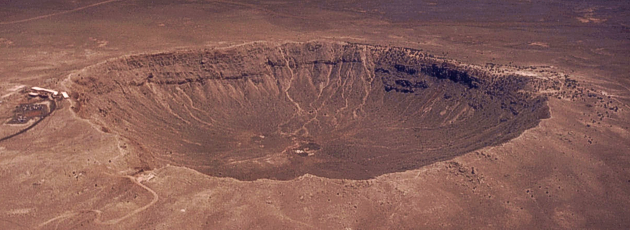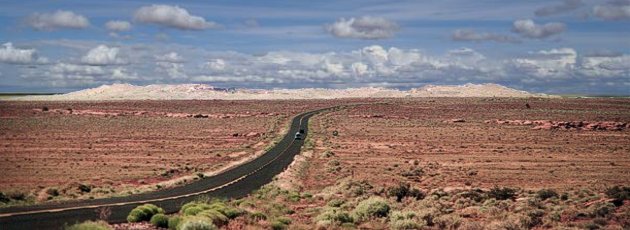- Barringer Meteorite Crater
- The Barringer Meteorite Crater is located near Winslow Arizona USA. It is about 155 meters ( 508ft ) deep and 1300 meters ( 4265ft ) wide and was formed about 50,000 years ago when a meteor about 50 meters in diameter and weighing several hundred thousand metric tons hit the Earth at a speed of about 54,000 kilometers per hour.

The Barringer Meteor was composed mostly of iron and nickel. This means it probably came from the core of a small planet or large asteroid which collided with another similar object during the formation of the solar system. The energy released from the impact is estimated to have been 30-40 megatons. Over 175 million tons of debris was displaced including pieces of rock the size of small houses. Ejecta and meteorite fragments were dispersed in a radius up to 10 kilometers from the impact center. Some of the meteor fragments found in the Diablo Canyon area weigh over 1000 pounds and are known as the Diablo Canyon Meteorites.
The crater was likely discovered first by native Americans. However it is not known for certain when or by whom. The first documented references to the crater were made in 1891 by Grove Karl Gilbert, the Chief Geologist of the US Geological Survey ( USGS ). In those days there was little scientific knowledge about meteors and impact craters so Gilbert assumed that the size of crater would have been about the same size as the meteorite which made it and that such a meteorite would have a magnetic field. However further investigation found no magnetic field and the absence of a large intact meteorite led Gilbert to speculate that the crater was produced by molten lava coming into contact with water resulting in a volcanic steam explosion.
Gilbert's theory went unchallenged until 1902 when Daniel Moreau Barringer, a mining engineer from Philadelphia heard about the crater from his friend Samuel J. Holsinger. A few months later Holsinger reported to Barringer that meteoric iron and ejecta were randomly mixed around the crater edge. Barringer correctly reasoned that Gilberts volcanic hypothesis must therefore be inaccurate and that he should be able to locate the remains of the meteor core. So he enlisted another friend, mathematician and physicist Benjamin Chew Tilghman. Together they formed the Standard Iron Company, and secured mining patents for the crater and the land around it.
Between 1903 and 1905, Barringer and Tilghman conducted extensive exploration and drilling operations at the crater in an attempt to find the meteorite. Among other things, their data showed that the rocks surrounding the crater had been subjected to sudden and violent shock. However attempts to locate the meteorite itself were unsuccessful.
 In 1907 a geologist named George Perkins Merrill became interested in the debate over the craters origin and took it upon himself to visit the site. He concluded that
samples known as lechatelierite could only have been formed under pressure greater than any known to occur through terrestrial processes. He also reasoned that the
undisturbed rock beds below the crater negated the possibility of any explosive force from below, once again confirming that volcanic activity could not be responsible
for the crater.
In 1907 a geologist named George Perkins Merrill became interested in the debate over the craters origin and took it upon himself to visit the site. He concluded that
samples known as lechatelierite could only have been formed under pressure greater than any known to occur through terrestrial processes. He also reasoned that the
undisturbed rock beds below the crater negated the possibility of any explosive force from below, once again confirming that volcanic activity could not be responsible
for the crater.
Meanwhile, Barringer had been doing some ballistics experiments. By firing bullets into mud he discovered that regardless of the angle of impact, the result was always a circular crater. This important discovery led to an entirely new view of impact crater formation which suggested that any surviving meteorite core would be located under the crater's south rim. New drilling at this location revealed quantities of meteoric material and at 1376 feet the drill struck something hard and became stuck. A mine was begun in January 1928 to extract what was assumed to be the meteorite, but in November of 1928 underground water flooded the mine. Subsequently, Barringer's company was unable to secure the funding needed to continue the project and in September 1929 all operations were suspended. Barringer himself died of a heart attack in November of 1929.
The Barringer Meteorite Crater was deemed a Natural Landmark in 1968 by the U.S. Government and at the time this article was written, the Barringer family still owned the property. The meteorite core remains unretreived and the general opinion is that while Barringer may have located a larger segment during his final drilling phase, most of the original meteorite probably disintegrated upon impact. The photo above is a ground level view of the crater rim from a distance of about 5 miles.
Arizona has been host to many UFO sightings. On June 8, 1977, three people on their way from flagstaff to the Barringer Crater were traveling along interstate highway #40 near the town of Winslow when they noticed that an object about 40 yards ahead of them was not another vehicle. It was flying just above the road and shining a bright light down onto the ground. The UFO paced their vehicle for about ten miles before moving off. Barringer crater is also featured near the end of a 1984 science fiction motion picture titled Starman directed by John Carpenter. NASA also used the vicinity as training and testing grounds for its Apollo missions. This may provide an explanation for some of the circumstantial photographic evidence presented by those who perpetuate moon landing hoax theories.